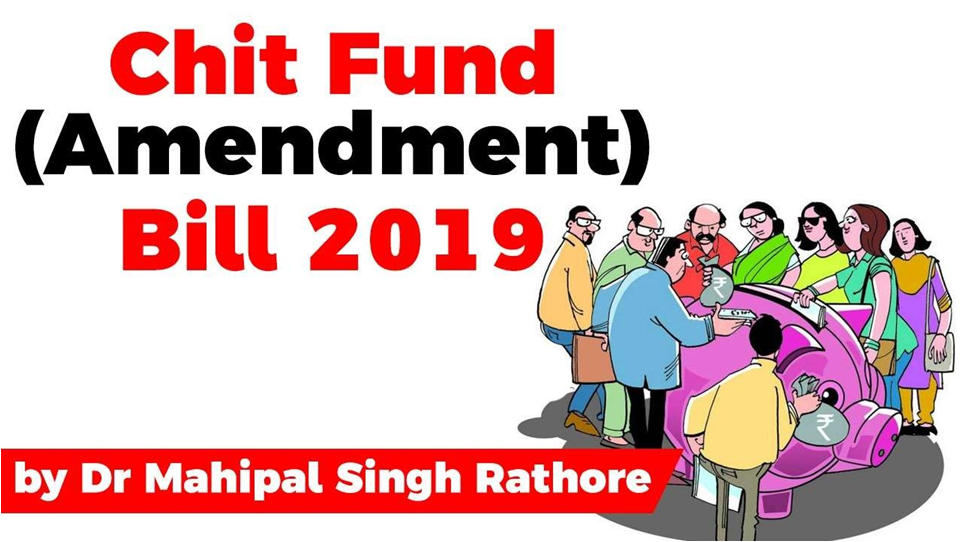Table of Contents

Why in news?
- The Lok Sabha on Wednesday passed the Chit Funds (Amendment) Bill, 2019 .
- The bill seeks to streamline operations of chit funds in India and protect the interests of investors, mainly the economically weaker sections of the society.
- The Bill amends Chit Funds Act, 1982.
What is a chit fund?
- A chit fund is a type of saving scheme where a specified number of subscribers contribute payments in instalment over a defined period.
- Each subscriber is entitled to a prize amount determined by lot, auction or tender depending on the nature of the chit

History
- Practice that is 100+ years old .
- Prevalent in Southern regions especially Kerala.
- Temples, Churches, Village based organizations
- During the 1930s, 166 banks were conducting chit funds in Kerala.
- The first state-run chit fund, Kerala State Financial Enterprises, was established in 1969 by the Kerala
- The company managing the chit fund (foreman) would retain a commission from the prize amount every month.
- India has thousands of unorganised chit funds that may be run informally among family, friends or acquaintances
- There are ~10,000 organised and regulated chit funds.

The recent PR Hit
- In the last few years, there have been several alleged frauds pertaining to companies such as Saradha Group, Rose Valley , Sahara etc
- They lured gullible investors to deposit money in their schemes in lieu of abnormally high returns and subsequently shut shop, leaving the rural poor in the lurch.
- In some cases, politicians were also alleged to have links with the tainted companies.
Who regulates Chit funds?
- The Reserve Bank of India (RBI) is the regulator for banks and other non banking financial companies (NBFCs) but does not regulate the chit fund business.
- As the regulator of the securities market, SEBI regulates collective investment schemes. But the SEBI Act, 1992 specifically excludes chit funds from their definition of collective investment schemes
- Saradha and Rose valley were not chit funds, technically; they were indulging NBFC operations
- The Chit Funds in India are regulated by the Chit Fund Act, 1982.
- Under this law, registration of the chit fund business can be done only by the respective state
- It prohibits a fund from being created without the prior sanction of the state government.
- There are over 10,000 registered chit fund in India
Changes brought by Chit Funds (Amendment) Bill, 2019
1) Names for a chit fund
- The Act specifies various names which may be used to refer to a chit fund.
- These include chit, chit fund, and kuri.
- The Bill additionally inserts ‘fraternity fund’ and ‘rotating savings and credit institution’ to this list.
2) Substitution of terms
- ‘chit amount’ as the sum of subscriptions payable by all the subscribers of a chit; ‘gross chit amount’
- ‘dividend’ as the share of the subscriber in the amount kept apart for running the chit; ‘share of discount’
- ‘prize amount’ as the difference between chit amount and the amount kept apart for running the chit. ‘net chit amount’
3) Presence of subscribers through video- conferencing
- The Act specifies that a chit will be drawn in the presence of at least two subscribers.
- The Bill seeks to allow these subscribers to join via video-
4) Foreman’s commission
- Under the Act, the ‘foreman’ is responsible for managing the chit fund.
- He is entitled to a maximum commission of 5% of the chit
- The Bill seeks to increase the commission to 7%.
5) Aggregate amount of chits
- The Act specifies the maximum amount of chit funds which may be collected.
- (i) 1 lakh rupees for chits conducted by individuals, and for every individual in a firm or association with less than four partners, and
- (ii) 6 lakh rupees for firms with four or more partners.
- The Bill increases these limits to 3 lakh rupees and 18 lakh rupees,
6) Application of the Act
- Currently, the Act does not apply to:
- (i) any chit started before it was enacted,(1982)
- (ii) any chit (or multiple chits being managed by the same foreman) where the amount is less than Rs 100.
- The Bill removes the limit of Rs 100, and allows the state governments to specify the base amount over which the provisions of the Act will apply.
What are the benefits of a chit fund?
- 0% interest rate – banks charge interest on the loan.
- No documentation /paper work – The bank might reject your loan request due to insufficient proof of document. However, chit funds do not need any document proofs.
- Access to funds and options to save for people in rural areas.
- An option for the large segment of population without banking services.
Negatives
- It requires a very high level of trust.
- It was a good mechanism 100+ years ago when bank facility was not available. Today Bank are ubiquitous and terms are customer friendly
- Financial literacy still very low – confusion with other products/schemes
- Scams
Latest Burning Issues | Free PDF






















 WhatsApp
WhatsApp